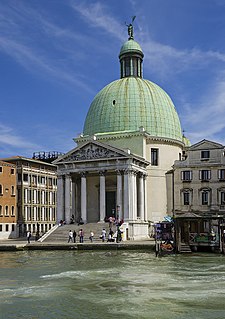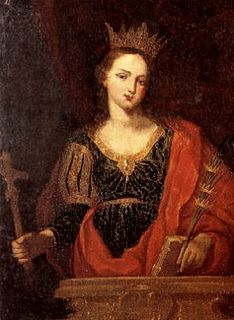
Saint Lawrence or Laurence was one of the seven deacons of the city of Rome, Italy, under Pope Sixtus II who were martyred in the persecution of the Christians that the Roman Emperor Valerian ordered in 258.
Eudoxia, Eudokia or Evdokia is a feminine given name, which originally meant "good deeds" or "she whose deeds are good" in Greek. The Slavic forms of the name are East Slavic: Evdokiya, Yevdokiya ; South Slavic: Evdokija (Евдокија), Jevdokija (Јевдокија). It was mainly popular in late antiquity and during the Middle Ages, particularly in Eastern Europe. It continues in use today, usually in honor of various saints.

Fiesole is a town and comune of the Metropolitan City of Florence in the Italian region of Tuscany, on a scenic height above Florence, 5 km northeast of that city. Both Harvard University and Georgetown University have their centers of Italian Renaissance Studies domiciled in Fiesole. The Decameron by Giovanni Boccaccio is set in the slopes of Fiesole. The city was equally featured in the novels Peter Camenzind (1904) by Hermann Hesse and A Room with a View (1908) by E. M. Forster.

The Basilica of St. Mary of the Angels and the Martyrs is a titular basilica church in Rome, Italy built inside the ruined frigidarium of the Roman Baths of Diocletian in the Piazza della Repubblica.

Maiori is a town and comune on the Amalfi coast in the province of Salerno. It has been a popular tourist resort since Roman times, with the longest unbroken stretch of beach on the Amalfi coastline.

The Basilica of Saint Praxedes, commonly known in Italian as Santa Prassede, is an ancient titular church and minor basilica in Rome, Italy, located near the papal basilica of Saint Mary Major. The current Cardinal Priest of Titulus Sancta Praxedis is Paul Poupard.

San Martino ai Monti, officially known as Santi Silvestro e Martino ai Monti("SS Sylvester & Martin in the Mountains"), is a minor basilica in Rome, Italy, in the Rione Monti neighbourhood. It is located near the edge of the Parco del Colle Oppio, near the corner of Via Equizia and Viale del Monte Oppio, about five to six blocks south of Santa Maria Maggiore.

Guardialfiera is a comune (municipality) in the Province of Campobasso in the Italian region Molise, located about 30 kilometres (19 mi) northeast of Campobasso. It sits on a hilltop overlooking Lake Guardialfiera, which was created as a result of the damming of the Biferno river.

San Simeone Piccolo is a church in the sestiere of Santa Croce in Venice, northern Italy. From across the Grand Canal it faces the railroad terminal serving as entrypoint for most visitors to the city.

Justina of Padua is a Christian saint and a patroness of Padua. She is often confused with Justina of Antioch.

Cremona Cathedral, dedicated to the Assumption of the Blessed Virgin Mary, is a Roman Catholic cathedral in Cremona, Lombardy, northern Italy. It is the seat of the Bishop of Cremona. Its bell tower is the famous Torrazzo, symbol of the city and tallest pre-modern tower in Italy.

Santa Maria in Via Lata is a church on the Via del Corso, in Rome, Italy. It stands diagonal from the church of San Marcello al Corso.

Rufina and Secunda were Roman virgin-martyrs and Christian saints. Their feast day is celebrated on 10 July.

Saint Caesarius of Africa, also Caesarius of Terracina was a Christian martyr. The church of San Cesareo in Palatio in Rome bears his name.

Santa Maria dei Miracoli presso San Celso is a church and a sanctuary in Milan, Lombardy, northern Italy.

Saint Venera is venerated as a Christian martyr of the 2nd century. Little is known of this saint. The date of her death is traditionally given as July 26, 143 AD.
San Ciriaco de Camiliano was an ancient church of the city of Rome, formerly located on the present site of the Piazza del Collegio Romano near the Via del Corso. It was demolished in 1491 during construction on the church of Santa Maria in Via Lata.

















